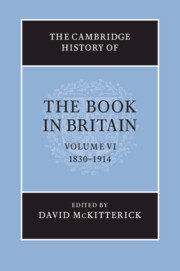Book contents
- Frontmatter
- Introduction
- 1 Changes in the look of the book
- 2 The illustration revolution
- 3 The serial revolution
- 4 Authorship
- 5 Copyright
- 6 Distribution
- 7 Reading
- 8 Mass markets: religion
- 9 Mass markets: education
- 10 Mass markets: children’s books
- 11 Mass markets: literature
- 12 Science, technology and mathematics
- 13 Publishing for leisure
- 14 Publishing for trades and professions
- 15 Organising knowledge in print
- 16 The information revolution
- 17 A place in the world
- 18 Second-hand and old books
- 19 A year of publishing: 1891
- 20 Following up The reading nation
- Bibliography
- Index
- Plate Sections
- References
10 - Mass markets: children’s books
Published online by Cambridge University Press: 28 March 2010
- Frontmatter
- Introduction
- 1 Changes in the look of the book
- 2 The illustration revolution
- 3 The serial revolution
- 4 Authorship
- 5 Copyright
- 6 Distribution
- 7 Reading
- 8 Mass markets: religion
- 9 Mass markets: education
- 10 Mass markets: children’s books
- 11 Mass markets: literature
- 12 Science, technology and mathematics
- 13 Publishing for leisure
- 14 Publishing for trades and professions
- 15 Organising knowledge in print
- 16 The information revolution
- 17 A place in the world
- 18 Second-hand and old books
- 19 A year of publishing: 1891
- 20 Following up The reading nation
- Bibliography
- Index
- Plate Sections
- References
Summary
Introduction
A ‘generational theory’, with phases running in fairly well-defined thirty-year cycles, has been applied to the development of the British children’s book from the first attempts to write its history. James Pettit Andrews and Sarah Trimmer both designated the 1740s as the foundation period, which saw the start of publishing for young readers as a continuously developing sector of the book trade. They also characterised the years between 1770 and 1800 as notable for the increased diversification, specialisation and proliferation of the children’s book. Neither lived long enough to pass judgement on the next phase, 1800–30, regarded as the first flowering of imaginative writing, illustration and book design, dominated by innovative entrepreneurs such as John Harris, Benjamin Tabart and the William Dartons. But by 1820, disenchantment had set in, signalling the coming shift from Enlightenment moral priorities to Victorian religious values. John Scott, editor of the London Magazine, observed that while instructional books had improved significantly during previous decades, imaginative literature for children had become unacceptably coarse, worldly and superficial to be worthy of its readers or reflect credit upon the authors. More importantly, he grasped that presentation was now integral to the concept of a children’s book. Improving the genre meant taking into consideration the way word, image and binding were packaged for an audience whose senses were remarkably receptive to any surface that could be printed upon, coloured or illustrated. The children’s book was no longer synonymous with a text-block adorned with cuts.
Keywords
- Type
- Chapter
- Information
- The Cambridge History of the Book in Britain , pp. 382 - 415Publisher: Cambridge University PressPrint publication year: 2009
References
- 1
- Cited by

